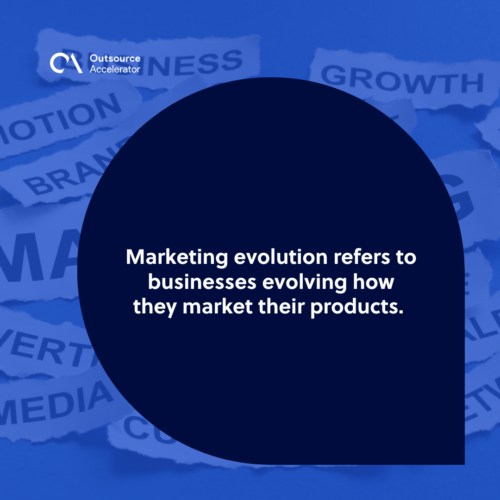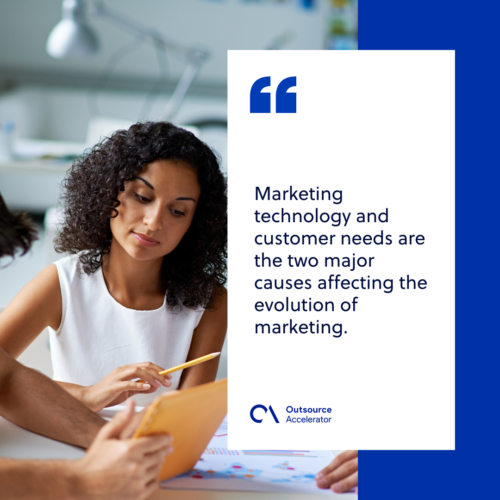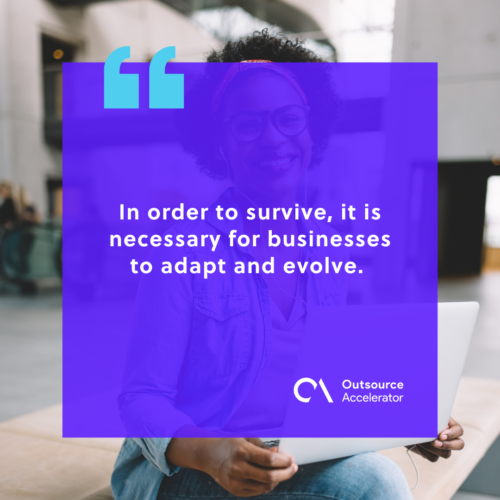An overview of marketing evolution

From going door-to-door to creating a social media campaign, the phenomenon of marketing evolution has gone through many changes throughout history.
Marketing has undergone quite a transformation driven by different forces and the need to reach ever-rising financial goals.
What does marketing evolution mean?
Marketing evolution refers to businesses evolving how they market their products. This encompasses the entire marketing history, with distinct phases identifying where important changes occurred to seek customer revenue and partnerships.
The term “marketing” can be traced back to the 1560s, though the practice had been in use for far longer. It is described then as “buying and selling, the act of transacting business in a market.”
The word came into its modern business meaning in the 1890s. It was defined as “a process of moving goods from producer to consumer, with an emphasis on advertising and sales.”
While in the past, vendors would simply inform potential customers about the presence of a certain product, now there is a complicated web of interactions.

Businesses compete for consumers’ attention through different channels like print and digital social media.[1]
In recent times, the shift has trended towards making the customer the central focus.[2] All forms of marketing are essential to reach customers and making a business successful.
Studying marketing evolution enables businesses to leverage modern marketing techniques, technology, and new communication strategies.
It’s a way to keep your brand current, even as marketing evolution occurs in real-time as we move into a new virtual era.
What causes marketing to evolve?
Marketing technology and customer needs are the two major causes affecting the evolution of marketing.
Print marketing outside stores was vendors’ best option to make their products known to a wider audience. Today, digital marketing can be seen in multimedia platforms, text messaging, or emails.
It’s also important to note that what customers demand[3] today will not be the same as what they will demand tomorrow. Lives and tastes change, and it’s the role of marketers to keep up with their audience.

Observing marketing evolution today, we can also identify more specific factors that cause changes:
International cooperation
The political and socio-economic scenario of the world changes all the time, making their influence on the global markets inevitable. Marketing follows the same way.
With a relatively more cooperative world today, large and small businesses can take advantage of entering joint ventures through international collaboration.
With marketing on a global scale, state-of-the-art technology is at the forefront, as well as global distribution.
With a wider market now open, more companies aim to manufacture and market products and services to international markets, especially Western audiences.
Mass communication and transportation
There is a much greater awareness today of what is and isn’t on the market. The spread of electronic media, television, audio-visual systems, and the internet has helped greatly in this.
More avenues of communication[4] mean that customers can correspond amongst themselves about the qualities and performance of a product. Skilled marketers can leverage these conversations to ensure their product is always on the collective mind.
Transportation is much the same as urban and rural interactions occur more regularly. This has all helped to change consumer attitudes, something that marketers should take note of.
Better standard of living
Even in rural areas of developing countries, the potential for industrialization is high. While it’s difficult to observe in the present day, overall standards of living have generally increased throughout history.
The greater prosperity of the world means that people enjoy a higher disposable income, which can then be used to purchase goods. Marketing evolution then informs strategies to do so.
Increased educational level
Across the world, considerable amounts of finance and effort have been devoted to increasing the population’s level of education and literacy.
In places where this has succeeded, the educated consumer enjoys a greater awareness of products and services. No longer being victimized by snake oil salespeople, these people now demand better products.
As the target audience evolves, so must the marketing. Marketing must now anticipate consumers’ responses to the product and prepare accordingly.
Social behavior
As the educational level of a population increases, so does the way it approaches the world. This then produces social behavior changes, affecting the nature and demand for certain products and services.
In order to survive, it is necessary for businesses to adapt and evolve. Their marketing techniques especially need to be reconfigured to convince audiences to still buy their product.
In particular, Western lifestyles seem to hold on large portions of the world, primarily due to their visibility in the media and pop culture.
The taste for electronic and smart devices and entertainment has also grown tremendously in a few years.

Demand for technology
Technology has quickened the pace of production to an unprecedented degree. Not only are products made more rapidly due to automation, but they are also changed and improved to meet customer preferences.
Product life cycles are becoming shorter, and consumers continually seek superior versions of products. Marketing evolution also moves faster than ever to keep up.
Increased competition
The current period of industrialization has made the manufacturing base go up. More businesses than ever are manufacturing consumer products, and they are all competing against each other.
Consumers have more options now, and marketing must evolve to grab the attention of key groups. Businesses that don’t take action to do so will find their existing customers leave for others.
The stages of marketing evolution
There are generally five eras that divide the history of marketing evolution. These stages are marked by a widespread change that redefines the dynamics of marketing and selling during those periods of history.
Simple Trade Era
Taking place from the 1400s to the late 1700s, this era preceded the concept of large-scale production. Only handmade products were on sale during this period.
The common practice was that people would make goods mainly for their household to use. Anything else was then sold.
As time went on, marketplaces were set up for multiple people to sell their products in one location. People would have to physically make the journey to these marketplaces to see what was available.
Production Era
From the 1800s to the 1920s, the production era took place. The stage had been set for the Industrial Revolution, where the focus was the mass production of common products.
The prevailing idea among businesses was that products should be inexpensive and available everywhere. This pushed businesses to produce as much as possible while keeping costs low, regardless of the quality of output.
Machinery became more widespread, and hundreds of factory workers were employed to keep up with demand. Efficiency was seen as the main goal.
As for marketing, the belief was that a cheap and available product would speak for itself, and national advertising would cease. Efforts were made to distribute as widely as possible.
Towards the end of this era, philosophy began to shift. While still product-centric, attention was turned to the product’s quality rather than quantity. Marketing efforts were essentially having the product speak for itself.
Companies would market about quality, performance, and innovative product features. This has since evolved, and today this strategy is not enough, as a product must also be appropriately priced and distributed.
Sales Era
This era took place from the 1920s to the 1940s. During this time, more and more companies joined the field. A good product by itself was fine when you were the only game in town, but now companies had to play with others.
As a result, marketing evolved to become more aggressive and competitive. Two core ideas were developed: the importance of brand identities and an emphasis on selling orientation.
This era of marketing evolution began to take advantage of new, different channels. Advertisements were shown through different platforms like print, radio, and television. Salespeople would even go door-to-door to sell products directly.
The marketing process would only take place after products had already been made. Businesses would also only sell what they ordered to make instead of what the market wanted to buy. Sales volume was still key.
Marketing Era
Happening from the 1940s to the 1990s, this period marked a particularly significant shift in marketing evolution. Iconography was made a priority in marketing, and the ads did most of the talking.
The shift from product-centricity to customer-centricity was also beginning. The customers’ needs were starting to be understood, and only by serving them could businesses make an impact. Marketing research really took off here.
Thus, this period is notable for birthing the modern marketing concept. This revolved around the idea that business goals could be reached by catering to the needs of consumers before your competitors could.
It was all about providing the best customer experience. To achieve this, the marketing departments had become the ones initiating company strategies across the entire organization.
Relationship Era
Starting in the 1990s and continuing to the present, this era is also called the Holistic Era or the Societal Era. The main objective is to create long-lasting relationships with customers.
The marketing concept evolved to prioritize strategies that encouraged customer retention and loyalty. Digital marketing channels began to factor heavily in companies’ tactics to deliver incentives, and social media made brands highly accessible.
The relationship between companies and consumers was no longer one-sided. In fact, the shift had turned to consumers having more influence as the industry moved to value customer-centricity.
A large part of this era was the conception of societal marketing. Before this era, many companies were exposed for their unethical practices, especially those that harmed the environment.
Societal marketing arose from the conflict of interest between satisfying the customers’ short-term needs and society’s long-term benefit.
For example, a company may produce the most technologically advanced device ever but will need to mine half a mountain to do so.
Consumers eventually began to patronize only the companies that were socially and ethically responsible. Societal marketing would be companies’ methods of putting the spotlight on their advocacies to gain favor from consumers.
Marketing evolved to become integrated with all aspects of a company’s operations. It was directed outward and inward so that the entire organization was aware of the company’s goals.
Future
Marketing evolution doesn’t stop. New product, customer, and brand positioning approaches will result in innovative marketing techniques. Technology and customer needs will continue to play roles in this.
As the shift to online continues, consumers will gain more power than ever as they dictate which marketing content they receive and how they receive it.
Marketing evolution has led to a billion-dollar industry, with new jobs like content marketers, SEO marketers, and mobile marketers now in demand. People will always need to buy, and marketing will continue to evolve in response.
References
- Digital social media. Sharma, S. and Verma, H.V., 2018. Social media marketing: Evolution and change. In Social media marketing (pp. 19-36). Palgrave Macmillan, Singapore.
- Customer the central focus. Payne, A. and Frow, P., 2005. A strategic framework for customer relationship management. Journal of marketing, 69(4), pp.167-176.
- Customers demand. Timoshenko, A. and Hauser, J.R., 2019. Identifying customer needs from user-generated content. Marketing Science, 38(1), pp.1-20.
- Communication. Gurău, C., 2008. Integrated online marketing communication: implementation and management. Journal of communication management.







 Independent
Independent




